Learning how to stop dog barking in seconds seems like an impossible feat. Can this really be possible? To those who follow Doggy Dan's tips, it is! You can learn it here!
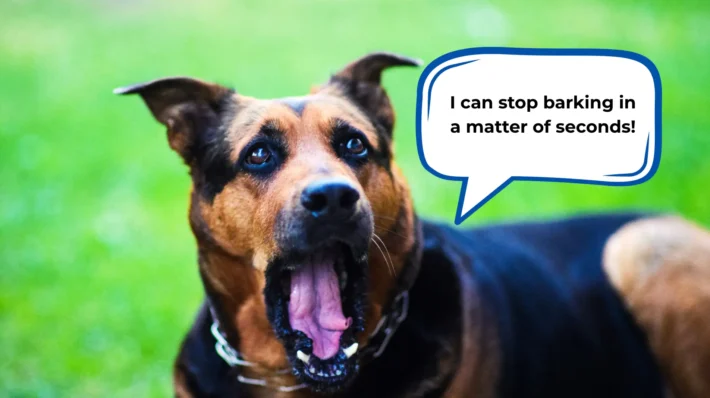
Even though barking is a completely normal tool of communication for dogs, it comes to a point that it becomes a problem.
Is your dog's barking driving you crazy? Here's the thing: they're not just making noise. They're trying to tell you something important.
“Hey, look! Listen! I'm trying to protect you!” That's what your dog's bark really means. But most owners miss the message. They try quick fixes: treats, clickers, even shouting. These rarely work long-term.
So, what DOES work?
Keep reading to discover the secret…
Key Takeaways
- Ensure Adequate Exercise and Rest: A tired dog is less likely to engage in excessive barking. Provide your dog with plenty of physical and mental exercise, which can help reduce boredom and frustration, common triggers for barking. Regular walks, playtime, and interactive toys can contribute to a calmer and quieter dog.
- Engage Your Dog's Mind: An occupied dog is less likely to bark out of boredom or loneliness. Offer your dog stimulating activities, such as puzzle feeders, interactive toys, or long-lasting chews. Keeping them mentally engaged can help tire them out and redirect their energy away from barking.
- Establish Yourself as the Leader: Dogs are pack animals and often bark excessively when they feel they need to take charge. By establishing yourself as the calm and confident leader, you can alleviate your dog's anxiety and reduce their need to bark excessively. This involves controlling resources like food and affection, setting boundaries, and calmly handling situations that may trigger barking.
Table of Contents
JOIN OUR FREE REACTIVITY CLASS AND CHANGE YOUR DOG'S BEHAVIOR IN DAYS!In Dog Psychology, What Does Excessive Barking Mean?
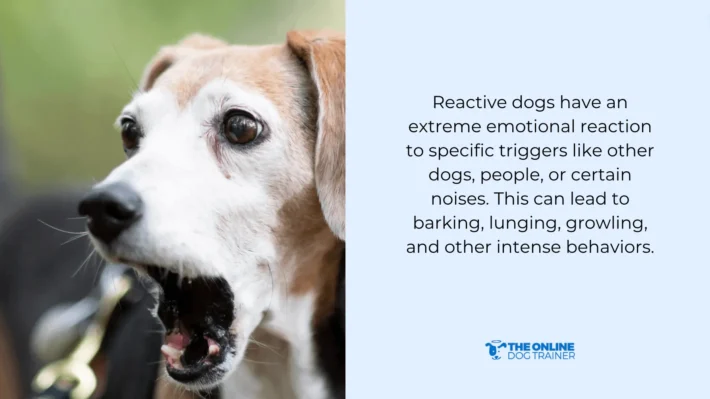
Dogs bark for all sorts of reasons: reactivity, aggression, fear, and even just to play! Let's break down the most common causes so you can better understand your furry friend.
Reactivity: The Over-the-Top Response
Reactive dogs have an extreme emotional reaction to specific triggers like other dogs, people, or certain noises. This can lead to barking, lunging, growling, and other intense behaviors.
What sets them apart: A reactive dog's response is way more intense than a normal dog's. Imagine a squirrel in the park: other dogs might glance, but a reactive dog barks, lunges, and pulls on the leash.
The root cause: Reactivity often stems from fear, anxiety, or over-excitement. They bark non-stop at things they're scared of, anxious about, or even overly excited by.
Fear, Anxiety, and the Protector Instinct
Many dogs bark due to unresolved fear and anxiety. When they encounter their triggers, barking becomes their defense mechanism.
- Past trauma: Dogs with a history of abuse or violence might excessively bark when they feel unsafe or when they feel there's a perceived threat.
- Protecting their pack: Your dog sees you as family, so they'll bark to defend you from anything they perceive as a threat. Most dogs are very protective and they show this through excessive barking.
How To Stop Dog Baking In Seconds
Want to know the real secret to stopping your dog's barking in seconds? It isn't a special command or a fancy tool. The secret is that your dog has to already see you as their trusted leader, long before the barking ever starts.
Pet parents, think of it this way: if a dog doesn't respect you as the one in charge, your commands are just noise. You can't expect immediate obedience from a dog who doesn't trust your judgment.
True leadership means building a foundation where your dog looks to you for guidance. They follow your word not out of fear, but because they trust that you are in control of the situation, the food, and the fun. When you have that level of trust, a single word from you is all it takes. When they trust you, the desired behavior you want from your dog can be achieved easily.
So forget shouting commands that fall on deaf ears. To get the results you want, you have to go beyond basic training and understand the core of dog psychology: on what really makes a dog listen and obey in seconds.
Below, I explain exactly how you can develop your dog's ability to listen to you in seconds!
How Loving Dog Leadership Stops a Barking Dog's Behavior
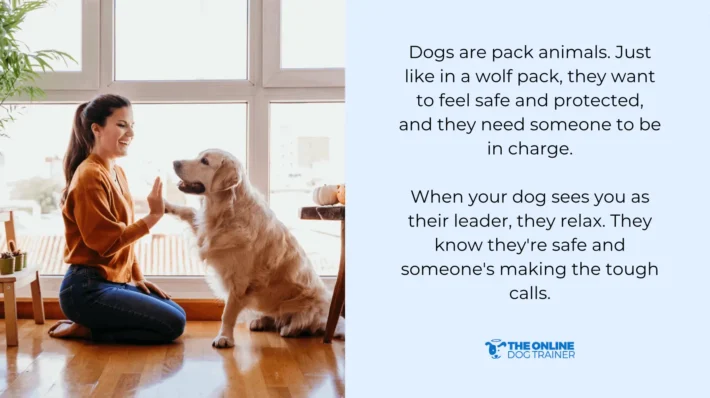
Dogs are pack animals. Just like in a wolf pack, they want to feel safe and protected, and they need someone to be in charge.
When your dog sees you as their loving, gentle leader, they relax. They know they're safe and someone's making the tough calls.
So, why is it crucial for YOU to be that leader? Keep reading to find out!
Dog Leadership Help Curb Excessive Barking Behavior Due to Reactivity
Dogs who think they're the boss are more likely to overreact. Here's why:
Imagine you're at the dog park, and your dog spots a a bigger dog (their worst nightmare!). If they think it's their job to keep themselves safe, they'll freak out, pulling, barking, and panicking to get away.
But, if they see YOU as their protector, the whole scene changes. Even if they see a larger dog, they'll stay calmer knowing you're there to handle things.
How Being a Leader Calms Down Barking Due to Separation Anxiety
Just like in the story above, fearful and anxious dogs are always on guard, on the lookout for threats to their and your safety. But when you take on the leadership hat, your dog learns to be calmer.
JOIN THIS FREE CLASS AND GET MY 5 GOLDEN RULES FOR FREE!How Leadership Helps Overprotective and Territorial Dogs
I always tell dog owners this: a dog stops barking when it realizes it's not in charge of you or the property.
When you show your barking dog actions that say, “Hey, I'm in charge here. I can protect myself, and I will protect you,” your dog will get it. They're fast learners. They get the message they can take the back seat—they know you can confidently protect the property!
How Leadership Stops Attention Seeking Barking
When your dog barks at you to throw a ball or give it a treat, who's really in charge in that moment? Your dog is. They have learned that barking is the command that makes you act.
By stepping up as the leader, you flip that script. A leader controls all the resources—and that includes fun things like toys, treats, and affection. You are the one who decides when playtime starts and ends. When you ignore the demand barking and only reward your dog when they show calm and quiet behavior, they learn a powerful new lesson: barking gets them nothing, but polite behavior gets them everything. You're not just stopping the barking; you're teaching them a more respectful way to ask for what they want.
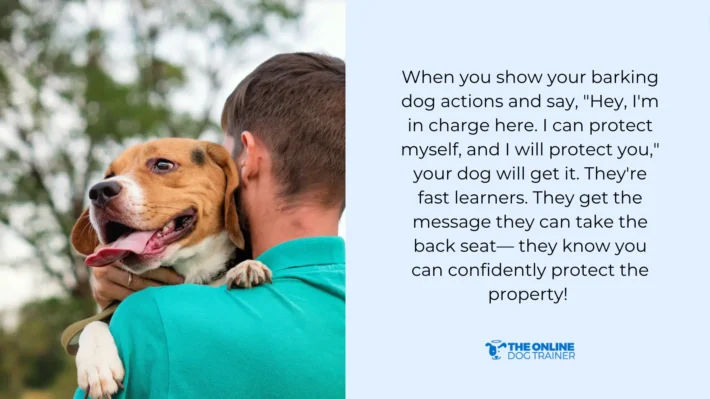
How to Be A Leader In Your Dog's Eyes: Doggy Dan's Five Golden Rules of Dog Leadership
Rule #1: You Control the Food
To your dog, food isn't just a treat, it's survival. That's why it's not enough to just feed them – you need to be in control of their food.
Food is their world, their most valuable treasure, and their most powerful training tool. If you leave bowls out all day, let them have bones whenever they want, or even worse, let them eat before you do; they'll think they're the ones in charge. This includes those sneaky floor scraps they snatch up and the bones they bury.
Even if you're the one buying the food, it doesn't matter if your dog has free access to it. They need to understand that YOU control the food, YOU decide when and how they eat.
This isn't about starving your dog; it's about teaching them a crucial lesson. Done correctly, controlling your dog's food can lead to a dramatic improvement in their behavior almost overnight.
I share exactly how you can do this in my FREE webinar!
THIS FREE WEBINAR WILL TEACH YOU HOW TO STOP REACTIVITY FOR GOODRule #2: You Control Affection and Attention
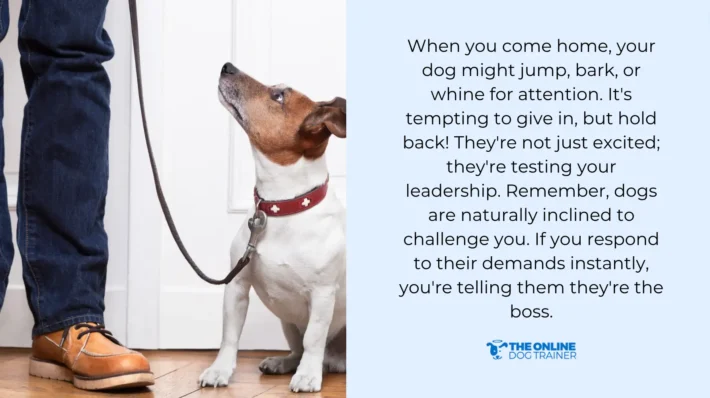
Absolutely shower your dog with love! But, like with food, affection should be on your terms. It's about who starts the cuddle session, not just the cuddles themselves.
When you come home, your dog might jump, bark, or whine for attention. It's tempting to give in, but hold back! They're not just excited; they're testing your leadership. Remember, dogs are naturally inclined to challenge you. If you respond to their demands instantly, you're telling them they're the boss.
Waiting to show affection isn't mean, it's essential. It proves that you're the leader, and they need to earn your love by being calm and respectful. Think of it like this: the leader of the pack doesn't just shower everyone with attention; they command respect first.
So, next time you come home or step out of the bathroom, don't rush to greet your dog. Remain quiet and let them settle down. Ignore them if your dog continues to bark for your attention. Once they're calm, then give them all the love they deserve. It's not about withholding affection; it's about giving it strategically to reinforce your leadership.
You can learn more about this in my FREE webinar.
Rule #3: Everything Should Be On Your Terms
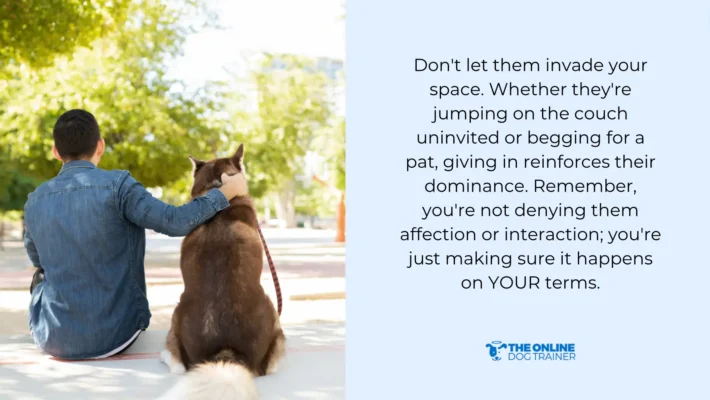
Every interaction with your dog has only two outcomes: either you're in control, or they are. This applies to everything – food, affection, walks, playtime, even cuddles. Your dog needs to understand that YOU make the decisions and YOUR word is final. Your role in their life is that important.
Why? Dogs are always checking who's the boss. They're experts at mind games, and their cuddles or demands for attention aren't always about affection. It's a subtle way of testing your leadership.
Don't let them invade your space. Whether they're jumping on the couch uninvited or begging for a pat, giving in reinforces their dominance. Remember, you're not denying them affection or interaction; you're just making sure it happens on YOUR terms.
By showing your dog that you're the leader, you're not just setting boundaries and establishing a clear hierarchy. You're also building mutual respect and understanding, which leads to a happier, more balanced relationship. This isn't about control for the sake of it but about empowering both you and your dog to live your best lives together.
I explain exactly how to do this in my FREE webinar!
FREE CLASS: LEARN HOW TO SOLVE REACTIVITY (NO FOOD, NO FORCE)Rule #4: You Deal with Danger
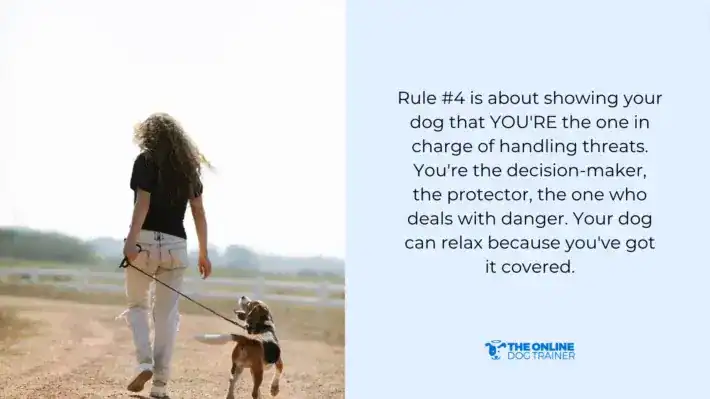
Your dog barks for a reason, usually because they sense danger. They're not just being noisy; they're trying to keep you safe. But sometimes, their protective instincts go a bit overboard. That's where you step in.
Rule #4 is about showing your dog that YOU'RE the one in charge of handling threats. You're the decision-maker, the protector, the one who deals with danger. Your dog can relax because you've got it covered.
How? Don't yell at them to stop barking. Instead, calmly acknowledge their concern with a “Thank you” and then check out the situation yourself. If you stay calm, your dog will pick up on your relaxed vibe and realize there's nothing to worry about.
By taking charge, you're not just stopping the barking. You're also building trust and confidence in your leadership. Your dog learns that it can depend on you to handle danger, which ultimately makes them feel safer and more secure.
I share more about the steps to make your dog trust your leadership in my FREE webinar!
Rule #5: You Control the Walk
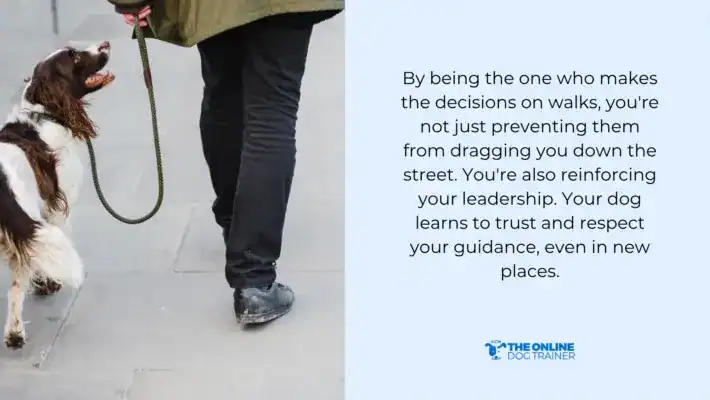
Your role as leader doesn't end at the front door. When you're out on walks, it's still YOUR walk, YOUR pace, YOUR route.
This means you decide when you start and finish, and you're not afraid to stop or turn around if your dog acts out. If they pull, bark, or misbehave, it's a sign they think they're in charge.
Keep their excitement in check. Don't give in to their demands or reward their hyperactivity. Wait until they're calm before starting the walk. Remember, a calm dog is a focused dog.
By being the one who makes the decisions on walks, you're not just preventing them from dragging you down the street. You're also reinforcing your leadership. Your dog learns to trust and respect your guidance, even in new places.
I share more tips about establishing your leadership while you're out in a walk with your dog. Register in my FREE webinar to learn more.
JOIN MY FREE REACTIVITY CLASS TO STOP NONSTOP DOG BARKING FOR GOOD)How to Teach Dog To Stop Barking Try This Effective Exercise!
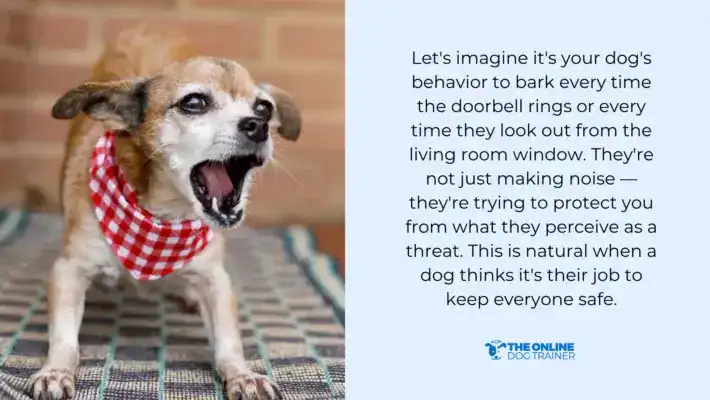
As a professional dog trainer, I've seen countless cases of incessant barking. But I've also learned a simple yet powerful technique to training dogs to stop compulsive barking.
Let's imagine it's your dog's behavior to bark every time the doorbell rings or every time they look out from the living room window. They're not just making noise — they're trying to protect you from what they perceive as a threat. This is natural when a dog thinks it's their job to keep everyone safe.
But as we've discussed, showing your dog that YOU'RE the leader, the one who handles danger, is key to curbing excessive barking. Here's a practical exercise to do when your dog starts barking:
Acknowledge Their Barking
Instead of yelling, “Quiet!” let your dog know you hear them.
A calm “Thank you” is enough to show you know their concern without getting worked up. This is key because you can't be the protector if you don't even acknowledge the potential threat.
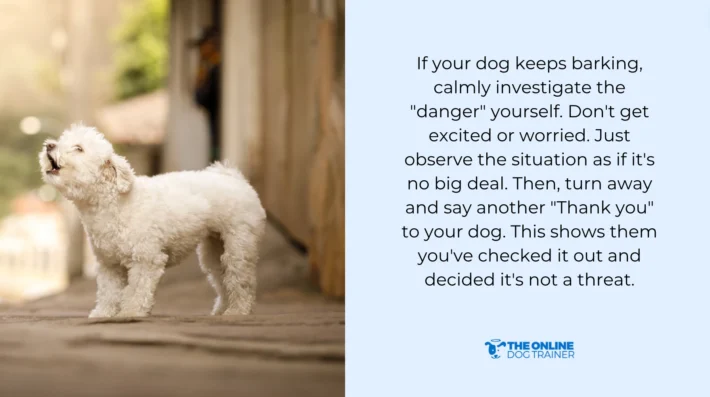
Assess the Situation Calmly
If your dog keeps barking, calmly investigate the “danger” yourself. Don't get excited or worried. Just observe the situation as if it's no big deal. Then, turn away and say another “Thank you” to your dog. This shows them you've checked it out and decided it's not a threat.
Do Time Out When Needed
If the barking persists, calmly put your dog in a timeout for a few minutes until they relax. A timeout—just like positive reinforcement—helps dogs understand that barking is unacceptable and allows them to calm down.
Lessons Your Dog Will Learn:
- I'm the Leader, I Deal with Danger: Your dog learns to trust your judgment and feels secure knowing you'll protect them. They don't always need to be on high alert because you're handling things.
- I Decide What's Dangerous: Your dog learns to differentiate between real threats and harmless events. It starts to understand that not everything is cause for alarm.
- I Take the Lead on How to React: Your dog learns to look to you for guidance and reassurance. They see your calm demeanor and realize they can relax, even in situations they might find stressful.
You build trust and confidence in your leadership by taking charge of danger. Your dog learns to rely on you, making them calmer and less reactive.
Things You Should Not Do When Trying to Make Dogs Stop Barking
Don't Yell Without Checking
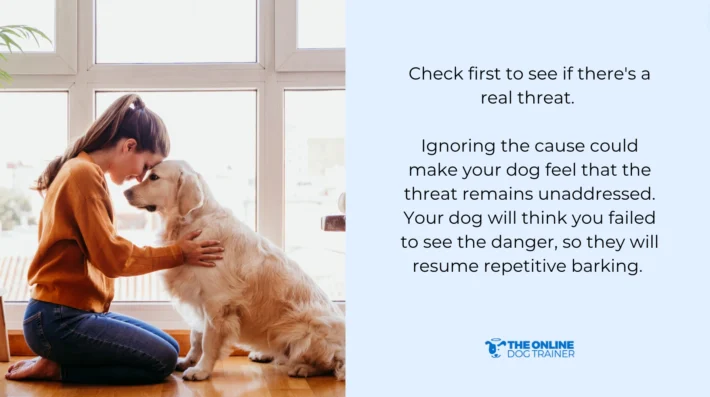
If your dog barks, don't just shout at them.
Check first to see if there's a real threat.
Ignoring the cause could make your dog feel that the threat remains unaddressed. Your dog will think you failed to see the danger, so they will resume repetitive barking.
Don't Show Negative Emotions
Your dog picks up on your energy. Even if you say “Thank you,” a harsh tone will signal them you're worried. Remember, your dog understands your energy better, more than your words. Dogs barking because of worry and stress can't switch to calm behavior if you're also agitated.
Don't Reward Barking
Stop giving treats, dog toys, or cuddles after your dog barks; it won't help in reinforcing correct behavior. They'll think barking is the way to get attention and will likely bark more often.
Don't Provide Affection During Barking
Comforting your dog while it barks confirms its fear and reinforces the barking behavior. You need to show it that you're in control and there's no need to worry.

Don't Cut Corners
Consistently following the “Thank you” method is crucial. Checking the barking triggers, staying calm, and giving timeouts (if necessary) are all steps to stop unwanted barking.
GET MY BESTSELLING DOG TRAINING PROGRAM FOR FREE!Get the Help of a Certified Professional Dog Trainer
When dogs bark excessively, you have to know the root cause so you can provide the right solutions. A certified professional dog trainer can help you with figuring out what's really wrong. You can also consult a certified applied animal behaviorist or a veterinary behaviorist.
Learn How to Reduce Barking Using Dog Psychology
If you want your dog to stop barking, you must go to the root cause: they think they're in charge. Temporary solutions like shouting or using dog treats like cheese and clickers will only solve the issue partially.
It's completely free. To learn more about becoming the dog leader who can stop a dog barking in seconds, click this link to join the Reactivity webinar.

~Doggy Dan




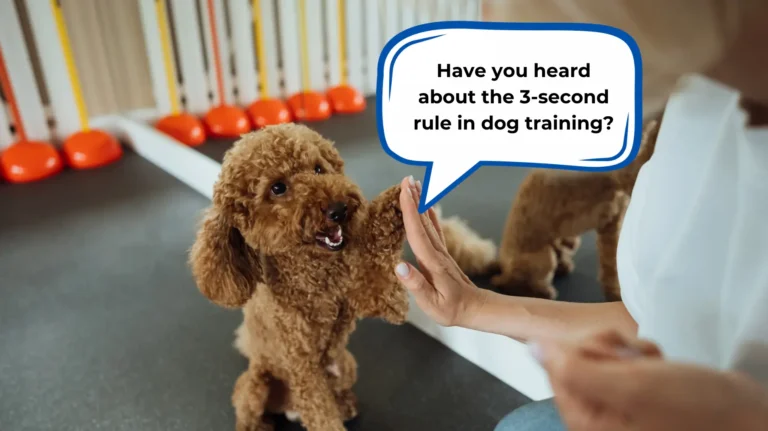
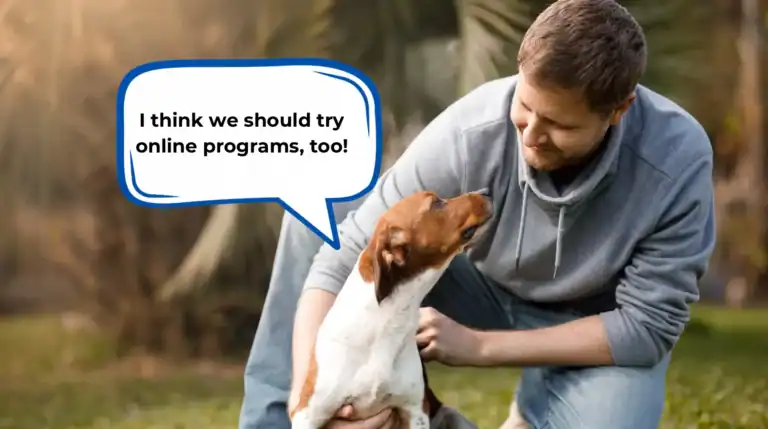
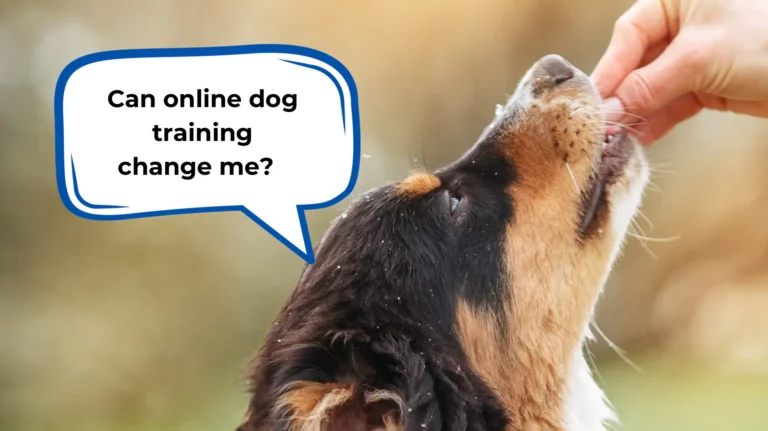
4 Responses
So informative. My dog is a barker for sure. Somehow through my behavior he has decided he’s in charge. I don’t mind it usually unless it means he’s gonna bark to protect me or the property. That’s when I have a problem with him. And it’s often and loud! I will try to use some of what you have said here. Thank you!
There are 5 Golden Rules. Apply them all and the barking will be under control in no time https://www.theonlinedogtrainer.com
Hi! This is all great advice. If the dog persists with barking after you have told them thank you and checked it out and let them know it’s all good- what would a “time out” then look like?
Somewhere boring with no visual. But, it must be done correctly. Unfortunately, I can not respond to every training question. However, if you sign up for the Complete Pack, there’s a forum within the program, which is the best place to post these questions. One of our very experienced trainers, Steve or Sophie, will then give you a detailed response. There’s also a lot more training content within. You can get in touch with the help desk to find out more. Cheers Dan